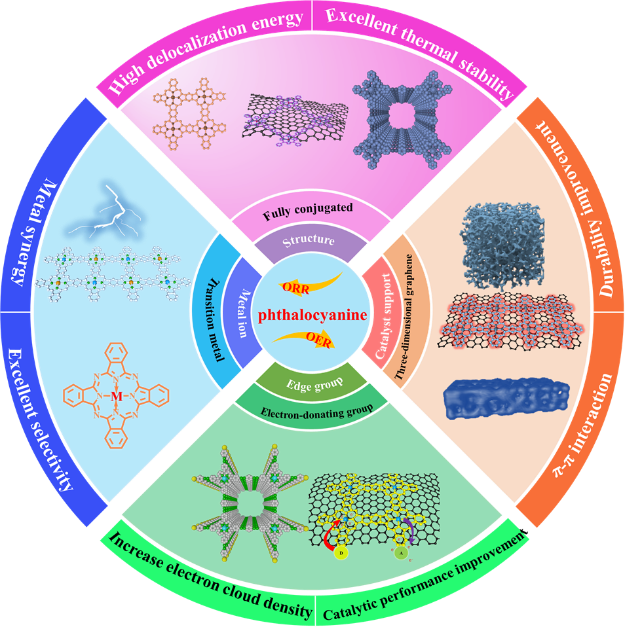 PDF(2918 KB)
PDF(2918 KB)


Preparation of Fully Conjugated Metal Phthalocyanine Complex Catalysts and to Enhance the Catalytic Oxygen Reaction Bifunctional Performance
Zhuang Yanqiong, Sun Yinggang, Sun Peng, Li Zhongfang
Prog Chem ›› 2025, Vol. 37 ›› Issue (9) : 1290-1300.
 PDF(2918 KB)
PDF(2918 KB)
 PDF(2918 KB)
PDF(2918 KB)
Preparation of Fully Conjugated Metal Phthalocyanine Complex Catalysts and to Enhance the Catalytic Oxygen Reaction Bifunctional Performance
Phthalocyanine transition metal macrocyclic complexes have been widely applied in electrochemical reaction processes related to energy conversion and storage, including catalytic oxygen reduction reaction (ORR) and oxygen evolution reactions (OER), etc. Their excellent bifunctional performance in catalytic oxygen reactions has attracted extensive attention. This article mainly reviews the preparation methods and current research progress of metal phthalocyanine-based catalysts, as well as the factors influencing the performance of metal phthalocyanine-based catalysts, such as the structure of metal phthalocyanine, the support, the synergistic effect of central metal ions and bimetallic ions, and the influence of edge modification groups, etc. The influence of the fully conjugated structure on its thermal stability and the improvement of catalytic performance was analyzed; The π-π interaction between polymeric metal phthalocyanine complexes and three-dimensional graphene is conducive to improving catalytic activity and durability. The synergistic effect between the two metals and the edge-modified electron-donating groups can enhance catalytic performance.
1 Introduction
2 Preparation of metal phthalocyanine complexes and their catalysts
3 Influencing factors of catalytic performance of metal phthalocyanine complex catalysts
3.1 The influence of the structure of metal phthalocyanine complexes on the catalytic performance of catalysts
3.2 The influence of the carrier on the catalytic performance of metal phthalocyanine complex catalysts
3.3 The influence of central metal ions on the catalytic performance of polymeric metal phthalocyanine-based catalysts
3.4 The influence of edge group modification on the catalytic performance of metal phthalocyanine complex catalysts
4 Conclusion

catalytic oxygen reaction bifunctional catalysts / transition metal macrocyclic complex / full conjugation COFs / π-π interaction / synergistic effect / edge modification effect
| [1] |
|
| [2] |
|
| [3] |
|
| [4] |
|
| [5] |
|
| [6] |
|
| [7] |
|
| [8] |
|
| [9] |
|
| [10] |
|
| [11] |
|
| [12] |
|
| [13] |
|
| [14] |
|
| [15] |
|
| [16] |
|
| [17] |
|
| [18] |
|
| [19] |
|
| [20] |
|
| [21] |
|
| [22] |
|
| [23] |
|
| [24] |
|
| [25] |
|
| [26] |
|
| [27] |
|
| [28] |
|
| [29] |
|
| [30] |
|
| [31] |
|
| [32] |
|
| [33] |
|
| [34] |
( 李忠芳, 姚福生, 王素文, 于如军, 王捷. CN1276918C, 2006 )
|
| [35] |
( 李忠芳, 王素文, 王旭涛, 张燕, 于先进. CN101327451, 2012 )
|
| [36] |
|
| [37] |
|
| [38] |
|
| [39] |
|
| [40] |
|
| [41] |
|
| [42] |
|
| [43] |
|
| [44] |
|
| [45] |
|
| [46] |
|
| [47] |
|
| [48] |
|
| [49] |
|
| [50] |
|
| [51] |
|
| [52] |
|
| [53] |
|
| [54] |
|
| [55] |
|
| [56] |
|
| [57] |
|
| [58] |
|
| [59] |
|
| [60] |
|
| [61] |
|
| [62] |
|
| [63] |
|
| [64] |
|
| [65] |
|
/
| 〈 |
|
〉 |